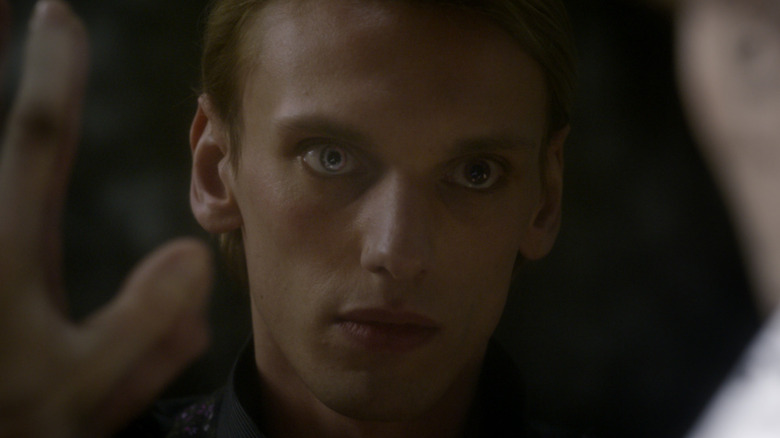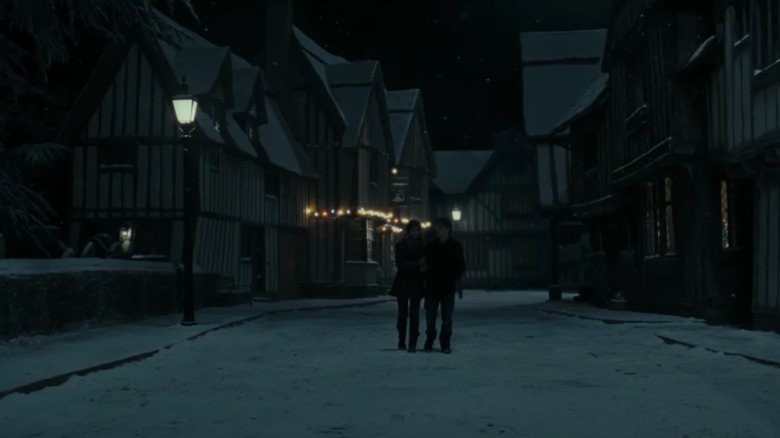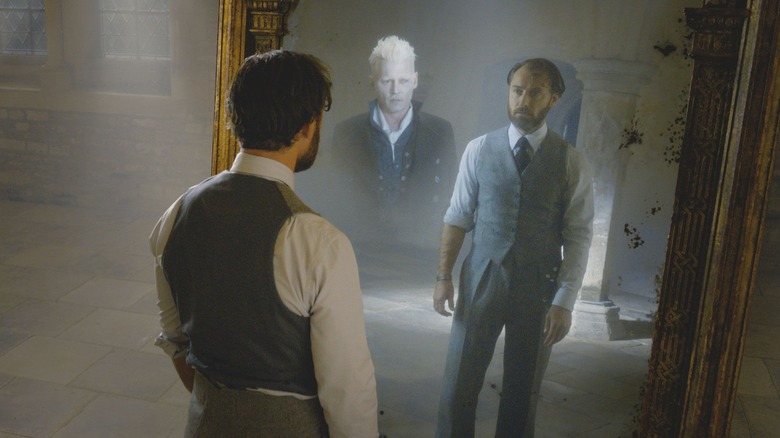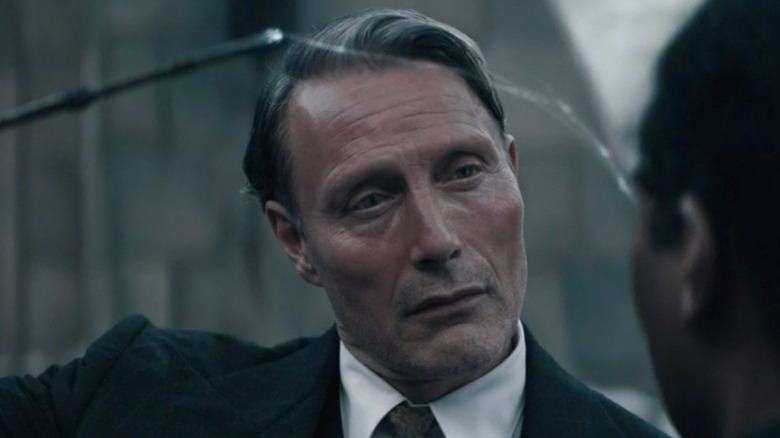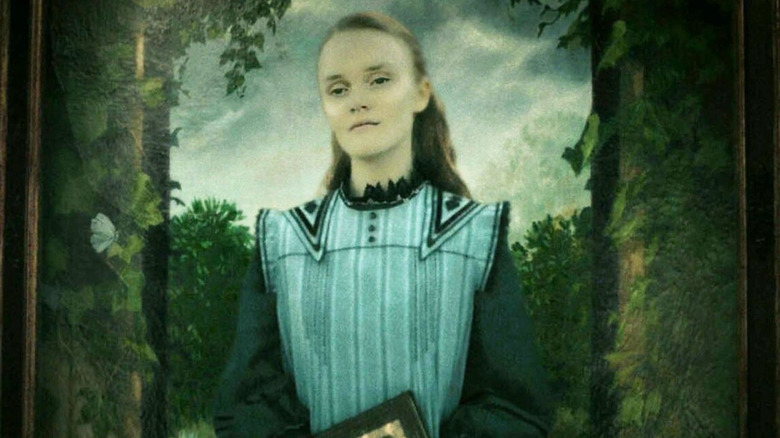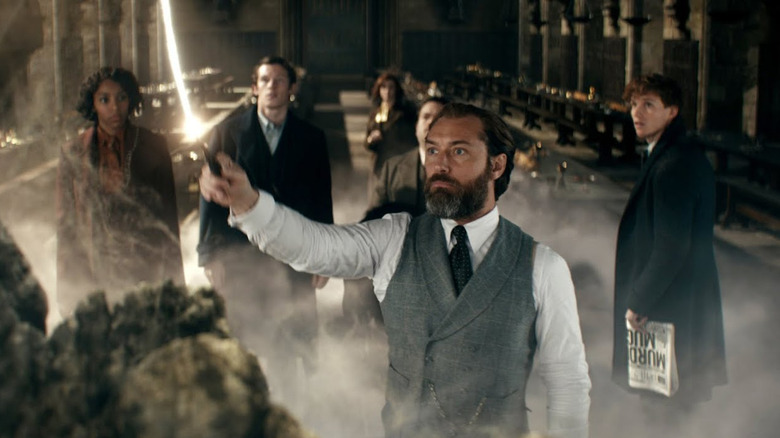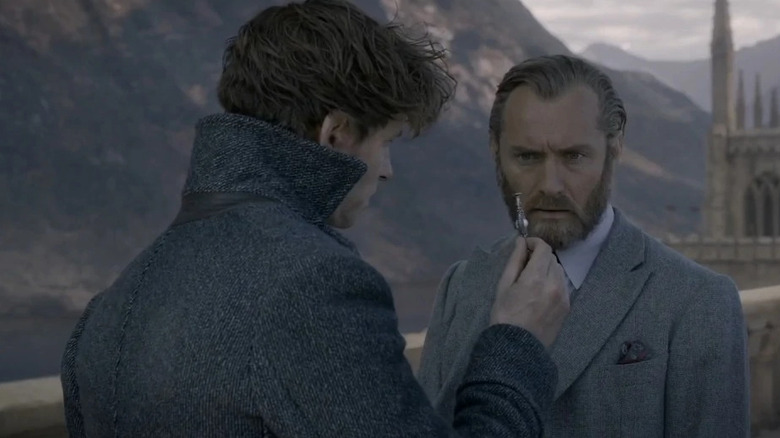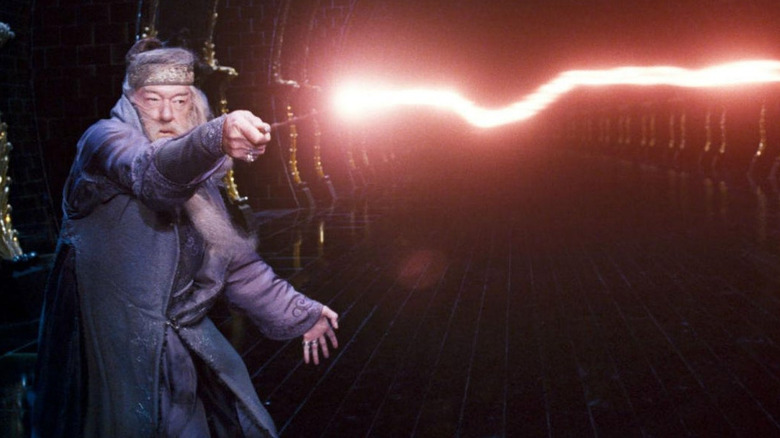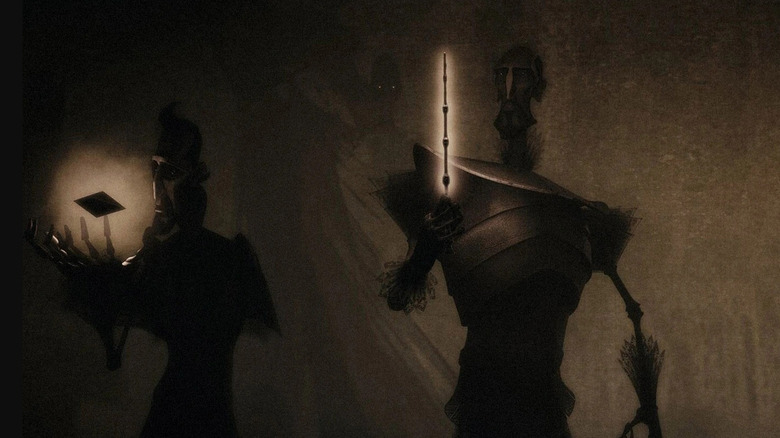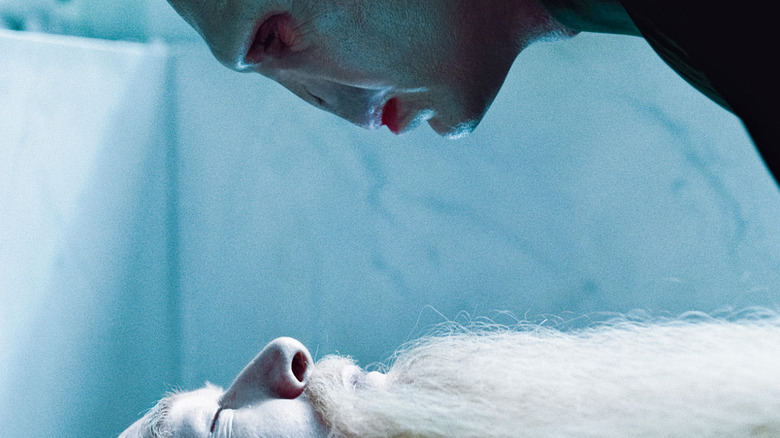Professor Dumbledore's History With Grindelwald Explained
One of the most famous rivalries in Wizarding World history started out with two young wizards yearning for friendship and acceptance. The relationship between Albus Dumbledore and Gellert Grindelwald eventually grew into a fraught and passionate one, with their histories, secrets and obsessions leading to an infamous duel that changed the course of the magical world's history.
Harry Potter fans know Dumbledore (Richard Harris and Michael Gambon) as the wizened, powerful old headmaster of Hogwarts and one of the most popular characters in the entire "Wizarding World" franchise. Grindelwald (Michael Biren in the "Harry Potter" film) is mentioned infrequently in the Harry Potter books and movies, mostly in relation to his duel with Dumbledore and the history of the wielders of the Elder Wand. In the "Harry Potter and the Deathly Hallows" book, Grindelwald is killed by Lord Voldemort in prison after he refuses to tell the dark wizard where the Elder Wand is. But in the movies, Grindelwald is not shown being killed by Voldemort and willingly tells him where to find the wand.
With the release of the "Fantastic Beasts and Where to Find Them" movie series, we're finally seeing more of Dumbledore's and Grindelwald's pasts and their relationship to one another — as well as how that passionate relationship built on love and trust turned ugly and impacted the whole of the wizarding world and beyond.
Here's everything to know about Dumbledore's history with Grindelwald.
Godric's Hollow
Dumbledore and Grindelwald were born just a couple years apart — Albus in 1881 and Gellert believed to have been birthed around 1883. The two met when Dumbledore was 17 in Godric's Hollow, where Grindelwald's great aunt Bathilda Bagshot lived. The author of "A History of Magic" also introduced the two young men.
Dumbledore grew up in Godric's Hollow and returned there after attending Hogwarts School of Witchcraft and Wizardry. He had a brother, Aberforth, and also a younger sister named Ariana — who had been emotionally scarred after an attack by a group of Muggles, which left her prone to dangerous magical outbursts. One of the outbursts accidentally killed the Dumbledore mother, Kendra, and Albus was left to care for his broken family.
It was at this point in his life when he met Grindelwald, who had been expelled from the Durmstrang wizarding school for "twisted experiments." At this point, the two were already some of the brightest and most powerful young wizards of their age, shaping each others ideas and destinies during the "two months of insanity" that they spent together in Godric's Hollow. It was during their time there that they fostered each other's grand ambitions and became obsessed with the Deathly Hallows.
An "incredibly intense" relationship
"Harry Potter" series author J.K. Rowling had already previously revealed that she always "thought of Dumbledore as gay" after the release of the final book in the series, and in a film extra in the Blu-ray edition of "Fantastic Beasts: The Crimes of Grindelwald," Rowling detailed more about his and Grindelwald's "incredibly intense" and "passionate" relationship.
Rowling confirmed that their relationship was one of love and that there was "a sexual dimension to this relationship." The two young men also became enthralled with each other's intelligence, ambitions and ideas about their place in the world and the relationships between Muggles and wizards. Despite their falling out after the death of Dumbledore's sister, the Hogwarts professor continued to see Grindelwald in the Mirror of Erised, a magical object that shows the user's greatest desire.
While Dumbledore seemingly abandoned these ideas of wizarding world dominance and "freedom" from persecution by the Muggles, Grindelwald went on to amass a veritable army of followers who shared his ideas. It's during this period — the 1920s in the "Fantastic Beasts" movies — that Dumbledore (Jude Law) and Grindelwald (Johnny Depp and Mads Mikkelsen) were being pushed to confront each other again.
The "greater good"
"For the Greater Good" was a sort of rallying cry for Grindelwald and his followers during the 1920s through the global wizarding war in the 1940s. Grindelwald's ideology of a world where wizards ruled over subservient Muggles was fostered during his time with Dumbledore in Godric's Hollow.
Because of the tragedy of Dumbledore's sister Ariana, who was left emotionally traumatized from an attack by Muggle boys, Dumbledore became infatuated with Grindelwald and his ideas to topple the International Statute of Wizarding Secrecy. "For the Greater Good" was coined by a Dumbledore as a way to justify the violence that would surely come to meet their goals of wise and gifted wizards and witches taking their "rightful place" above Muggles.
"He's mistrusted by the Ministry; they know he has this dark past in which he flirted with Grindelwald's ideology," Rowling said in a film extra on "Fantastic Beasts: The Crimes of Grindelwald." In "Harry Potter and the Deathly Hallows," Dumbledore tells Harry Potter more about his relationship with Grindelwald, their shared ideology and their obsession with the Deathly Hallows.
"It would all be for the greater good, and any harm done would be repaid a hundredfold in benefits for wizards. Did I know, in my heart of hearts, what Grindelwald was? I think I did, but I closed by eyes," Dumbledore said.
The death of Ariana Dumbledore
Dumbledore's youngest sibling was Ariana, who was six years old when she was attacked by a group of Muggle boys who saw her practicing magic. The attack left her so traumatized that she lost control of her abilities in a similar way that suppressing magic can lead to an uncontrollable, parasitic Obscurus. The Dumbledore patriarch, Percival, later attacked the Muggle boys in a fit of revenge and was imprisoned in Azkaban. Though the Dumbledore family hid Ariana away in Godric's Hollow to protect her, at the age of 14 she suffered an explosion of out of control magic and emotion, which killed her mother and forced Dumbledore to return home.
Dumbledore explains to Harry in "Harry Potter and the Deathly Hallows" that he "resented" having to forfeit his grand plans to care for his "damaged sister" and "wayward brother" Aberforth. He said he felt "wasted and trapped" in Godric's Hollow until Grindelwald came.
But when Aberforth confronted Dumbledore and Grindelwald about their horrifying plans for wizard dominance and their want to bring Ariana along with them, a three-way duel broke out between the young men. Ariana tried to stop the fight, but was unable to control her magic and was inadvertently killed by a stray curse. No one knew whose curse it was that killed Ariana. Dumbledore was haunted by the possibility that it was him who ended her life, so he pushed off facing Grindelwald for decades.
Newt Scamander and Fantastic Beasts
Dumbledore's relationship with the famous magizoologist Newt Scamander (Eddie Redmayne) rivals that of his future relationship with Harry Potter. With Newt, Dumbledore was his Defense Against the Dark Arts teacher, mentor and confidant, and they continued their relationship long after Newt left Hogwarts. It is during one of these Dumbledore-backed missions that we follow Newt in the "Fantastic Beasts" film series.
Newt became embroiled in the mission to capture Grindelwald when Dumbledore sent him to New York to return a Thunderbird to its rightful home in Arizona. In the second film, "The Crimes of Grindelwald," Grindelwald escapes the ministry's clutches and races to find Credence Barebone (Ezra Miller), who is an Obscurial after repressing his magical abilities. Dumbledore then sends Newt to Paris to rescue Credence, on his own quest to learn who he truly is.
Both Newt and Dumbledore are being watched by the Ministry of Magic, and Dumbledore is questioned at Hogwarts about his involvement with the search for Credence and Grindelwald. At the end of "The Crimes of Grindelwald," Newt shows Dumbledore the vial containing Dumbledore's and Grindelwald's blood pact, which was stolen off of Grindelwald by his Niffler. Newt then asks Dumbledore if he can destroy it so that Dumbledore (Grindelwald's match) can finally move against the dark wizard.
The blood pact
After Ariana's death, Dumbledore and Grindelwald broke ties, with the former eventually becoming a respected and beloved professor at Hogwarts and the latter gaining power and followers to his cause. For years, Dumbledore refused to confront Grindelwald, even as the dark wizard and his army terrorized the European continent in a bid to start their revolution. Part of this refusal had to do with Dumbledore's love for Grindelwald, but a big part had to do with the blood pact the two created when they were teens.
In the Wizarding World, a blood pact is made between two people who cut their hands with wands and hold them together while reciting an oath, mixing their blood. Once the pact is complete, drops of each person's blood swirl from their palms and fuse together with a vial forming around the bonded cells. The oath taken in a blood pact could be almost anything, but the vial and the pact itself was nearly impossible to destroy.
As teens, Dumbledore and Grindelwald made a blood pact to never fight each other — an oath made at the height of their brief but intense relationship in Godric's Hollow. In "Fantastic Beasts: The Crimes of Grindelwald." Newt Scamander's Niffler stole the shiny silver vial off Grindelwald during the battle at the Lestrange Family Mausoleum. Newt then brought the vial to Dumbledore at Hogwarts, asking the professor if it could be destroyed.
Knowing that Dumbledore and Grindelwald eventually do fight each other in 1945, it's safe to assume he and Newt find some way to break the vial — and the blood pact.
The duel
In 1945, one of the most famous duels in all of Wizarding World history took place between Albus Dumbledore and Gellert Grindelwald — former friends and lovers and arguably the two most powerful wizards in the world at the time.
Grindelwald had been amassing power and followers for decades and engaging in horrifying acts around the world in order to fulfill his goal of wizard domination over Muggles. While Dumbledore had once shared Grindelwald's ideals, he left his haunted history with the dark wizard behind and became a professor at Hogwarts teaching Defense Against the Dark Arts, Transfiguration and eventually becoming the Deputy Headmaster. Still, public outcry pointed to Dumbledore as the only wizard powerful enough to defeat Grindelwald.
Fans don't yet know when and how the blood pact between Dumbledore and Grindelwald was destroyed, but the infamous duel happened in 1945 — nearly 20 years after Newt Scamander's Niffler stole the vial off Grindelwald and brought it to Dumbledore. The Hogwarts professor won the duel and the allegiance of the iconic Elder Wand, which Grindelwald had stolen. Dumbledore's longtime friend Elphias Doge told Harry Potter of the awe and terror of witnessing the duel in "Harry Potter and the Deathly Hallows."
With Grindelwald defeated, the dark wizard was finally captured for good and sent to Nurmengard prison, a place he had built to hold his enemies. Dumbledore's victory in the duel earned him an Order of Merlin First Class award.
The Deathly Hallows
As teens, Dumbledore and Grindelwald shared a fascination with the concept of the Deathly Hallows. The same obsession was shared by Lord Voldemort decades later, during a similar quest to take over the wizarding world and defeat Harry Potter.
The story of the Deathly Hallows is told in "Tales of Beedle the Bard" in "Harry Potter and the Deathly Hallows" book and film. It's the story of three brothers who get three wishes from the manifestation of Death, wishing for something to bring people back from the dead (the Resurrection Stone), an all-powerful wand (the Elder Wand) and a means to hide from Death (Invisibility Cloak). The moral of the tale is that you cannot overcome or master death but instead should welcome death when it is your time — as the third brother, Ignotus Peverell, did with his cloak of invisibility.
The legend of the Deathly Hallows also said that anyone who possesses the stone, the wand and the cloak would be the master over death. Harry Potter is the only wizard known to have had all three objects at the same time. At one point, Dumbledore had all three objects, but was never the true owner of the cloak. Grindelwald possessed the Elder Wand for some time after stealing it from wandmaker Gregorovitch, but lost the wand when he was defeated by Dumbledore in a duel. Harry is the last person to have possessed all three objects — he purposely lost the Resurrection Stone in the Forbidden Forest, returned the Elder Wand to Dumbledore's grave (in the book) and passed along the Invisibility Cloak to his son, James.
Their deaths
The "Harry Potter" books and movies differ in their depictions of the deaths of Dumbledore and Grindelwald. In the books, Grindelwald is killed by Lord Voldemort after refusing to give the dark lord information about who now holds the Elder Wand. By the late 1990s, Grindelwald is a shadow of his former self, having starved and aged and gone mad in prison. But during his encounter with Voldemort, he taunts the dark wizard by using his real name and says the Elder Wand will never answer to him.
In the movie, Grindelwald (Michael Biren) seemingly gives up information on the Elder Wand to Voldemort and his death isn't shown, leaving the possibility open that Grindelwald could still be alive and in prison.
In the books and "Harry Potter and the Half-Blood Prince," Dumbledore is killed by Professor Severus Snape (Alan Rickman) and falls from the top of the Astronomy Tower. It is later revealed that Dumbledore begged Snape to end his life, as he was suffering from the painful curse of Marvolo Gaunt's ring, which contained the Resurrection Stone and had been turned into a Horcrux by Voldemort. Though it appeared to many that Snape killed Dumbledore in cold blood, the professor had been performing covert operations with Voldemort and his Death Eaters, in order to protect Harry and help save the entirety of the wizarding world.
